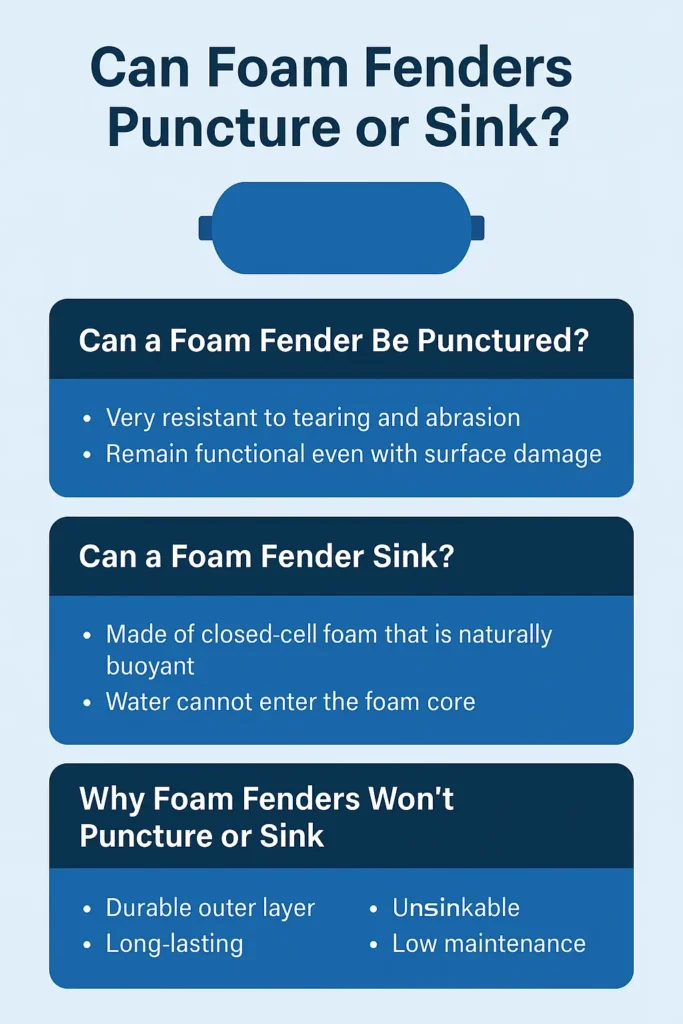Why This Question Matters
When it comes to protecting your ship or dock, you need equipment you can trust. One of the most popular solutions today is the foam fender. But many buyers wonder — can foam fenders be punctured? And if it’s damaged, will it sink?
Let’s explore the truth behind these common concerns.

What Is a Foam Fender?
Foam fenders are a type of marine fender made with a solid, closed-cell foam core. It’s wrapped in a durable outer layer, often made from tough polyurethane or reinforced rubber. Foam fenders are designed to absorb high energy from ship impacts while staying afloat and intact.
Unlike pneumatic (air-filled) fenders, foam fenders don’t rely on air pressure. That makes them a reliable, low-maintenance solution.
Can a Foam Fender Be Punctured?
It’s very hard to puncture foam fenders. The outer layer is made from materials that resist tearing and abrasion. But even if the surface is scratched or damaged, the fender won’t fail.
That’s because the inside is made from closed-cell foam — it won’t collapse or stop working after minor damage. Foam fenders can still function even with cuts or surface wear.
In short: yes, surface damage can happen, but no — foam fenders do not easily puncture or break.
Can Foam Filled Fenders Sink?
No, foam filled fenders will not sink — even if they’re damaged.
The foam inside is closed-cell, meaning water cannot enter it. This type of foam is naturally buoyant. Even if the outer skin is ripped or broken, the core remains dry and floating.
This is one of the biggest advantages of foam fenders:
They are unsinkable.
What Happens If a Foam Fender Gets Damaged?
If foam fenders get scraped or torn, they usually keep working just fine. In many cases, you can patch the outer layer with repair kits or professional help. Unless there is major structural damage, the fender’s performance stays strong.
Foam fenders are designed to be tough. They handle rough environments, frequent impacts, and even extreme temperatures.
How to Extend the Life of Your Foam Fender
Here are a few simple ways to keep your foam filled fenders in top shape:
- Inspect regularly for cracks or worn areas
- Avoid dragging the fender on rough surfaces
- Store properly when not in use (away from sunlight and chemicals)
- Clean after use to remove salt and dirt
With proper care, a foam fender can last for many years without any trouble.
Why Choose Foam Filled Fenders?
Here’s why so many professionals trust foam fenders:
- They don’t puncture easily
- They never sink
- They need less maintenance
- They work in all weather
- They’re ideal for ports, naval vessels, barges, and offshore rigs
If you want a fender that’s always ready, foam fenders are the smart choice.
Frequently Asked Questions
Q: Can a foam fender be used in rough seas?
A: Yes. Foam fenders are made to handle waves, impacts, and harsh marine environments.
Q: Will a foam fender still work if it has cuts or dents?
A: Yes. The foam core absorbs energy even if the outer skin is damaged.
Q: How long does a foam fender last?
A: With proper care, many foam fenders last 10+ years.
Conclusion: Foam Fenders Are Safe, Strong, and Unsinkable
If you’re worried about fender damage or failure, foam fenders should give you peace of mind. They’re built to resist punctures and guaranteed to stay afloat, even in tough situations.
For long-term protection and less maintenance, foam fenders are the best investment you can make for your ship or dock.


